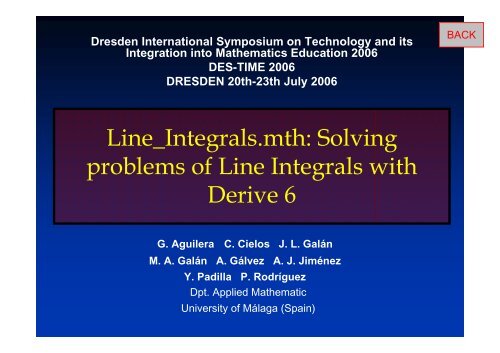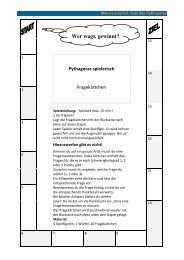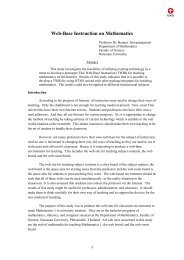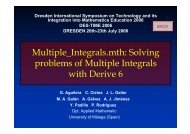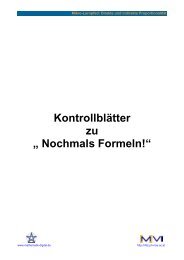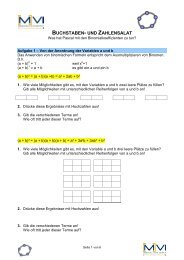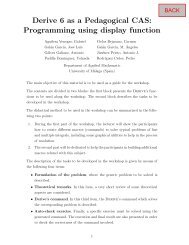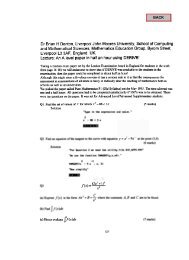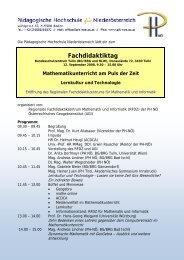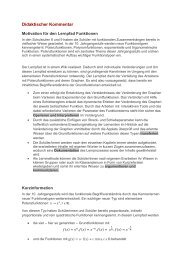Line_Integrals.mth: Solving problems of Line Integrals with Derive 6
Line_Integrals.mth: Solving problems of Line Integrals with Derive 6
Line_Integrals.mth: Solving problems of Line Integrals with Derive 6
Create successful ePaper yourself
Turn your PDF publications into a flip-book with our unique Google optimized e-Paper software.
Dresden International Symposium on Technology and its<br />
Integration into Mathematics Education 2006<br />
DES-TIME 2006<br />
DRESDEN 20th-23th July 2006<br />
<strong>Line</strong>_<strong>Integrals</strong>.<strong>mth</strong>: <strong>Solving</strong><br />
<strong>problems</strong> <strong>of</strong> <strong>Line</strong> <strong>Integrals</strong> <strong>with</strong><br />
<strong>Derive</strong> 6<br />
G. Aguilera C. Cielos J. L. Galán<br />
M. A. Galán A. Gálvez A. J. Jiménez<br />
Y. Padilla P. Rodríguez<br />
Dpt. Applied Mathematic<br />
University <strong>of</strong> Málaga (Spain)
Introduction.<br />
<strong>Line</strong>_<strong>Integrals</strong>.<strong>mth</strong>.<br />
Final conclusions.<br />
Index
Introduction<br />
In most cases, the use <strong>of</strong> CAS is reduced<br />
to using computers as powerful highperformance<br />
calculators.<br />
It is therefore necessary to change the<br />
way people think about information<br />
technologies in order to optimise the<br />
opportunities they <strong>of</strong>fer and try to<br />
encourage mathematical creativity among<br />
students.
Introduction<br />
Math teachers that use CAS have to change the<br />
traditional uses given to these tools.<br />
It is a mistake to use CAS in teaching as simple<br />
problem-solving machines.<br />
They should be used in ways that maximize the<br />
opportunities that these technologies <strong>of</strong>fer:<br />
positively affecting student learning, significantly<br />
increasing opportunities for experimentation and<br />
allowing students to construct their own<br />
mathematical knowledge.
Introduction<br />
Math teachers must first set out a series<br />
<strong>of</strong> appropriate activities.<br />
The use <strong>of</strong> CAS in Mathematics has not<br />
reached optimum conditions. Mostly are<br />
blackbox (showing the result in one step<br />
<strong>with</strong>out teaching students how to get<br />
there) and should be whitebox (showing<br />
intermediate steps).
Combining programming<br />
and CAS<br />
When students program, they must read,<br />
construct and refine strategies, modify<br />
previously written programs and lastly, use the<br />
programs to solve <strong>problems</strong>. This makes them<br />
the protagonists <strong>of</strong> their own learning.<br />
The most appropriate approach involves using<br />
programming and CAS together to allow<br />
students to create the specific necessary<br />
functions that will allow them to solve the<br />
<strong>problems</strong> involved in the subject matter under<br />
study.
Parametrization <strong>of</strong> curves.<br />
Exact differential forms.<br />
Potential function.<br />
<strong>Line</strong> <strong>Integrals</strong>.<br />
Contents <strong>of</strong><br />
<strong>Line</strong>_<strong>Integrals</strong>.<strong>mth</strong><br />
<strong>Line</strong> <strong>Integrals</strong> <strong>with</strong> respect to arc length.<br />
Applications <strong>of</strong> <strong>Line</strong> <strong>Integrals</strong>.
We prefer to use large names for macros<br />
instead <strong>of</strong> using shorthands because we<br />
think it is easier for pupils to remember the<br />
full name and, on the other hand, the large<br />
name <strong>of</strong> the macro allows to guess what it<br />
solves
Final Conclusions<br />
Our accumulated experience reveals that<br />
CAS are computer tools which are easy to<br />
use and useful in Mathematics courses for<br />
Engineering.<br />
The traditional uses given to CAS in the<br />
teaching <strong>of</strong> Mathematics for Engineering must<br />
be changed to maximize the opportunities<br />
<strong>of</strong>fered by CAS technologies. Optimal use<br />
should be aimed at improving student<br />
motivation, autonomy and achieving<br />
participatory and student-centred learning.
Final Conclusions<br />
One powerful idea involves combining CAS<br />
resources <strong>with</strong> the flexibility <strong>of</strong> a programming<br />
language.<br />
There exists reasonable evidence to show<br />
that making programs <strong>with</strong> <strong>Derive</strong> facilitates<br />
learning and improves student motivation.<br />
Although it would be desirable to do so, it is<br />
not necessary to substantially modify the<br />
traditional program <strong>of</strong> studies <strong>of</strong> Math courses<br />
for Engineering to introduce the innovation <strong>of</strong><br />
having students make their own programs<br />
<strong>with</strong> <strong>Derive</strong>.
Dresden International Symposium on Technology and its<br />
Integration into Mathematics Education 2006<br />
DES-TIME 2006<br />
DRESDEN 20th-23th July 2006<br />
<strong>Line</strong>_<strong>Integrals</strong>.<strong>mth</strong>: <strong>Solving</strong><br />
<strong>problems</strong> <strong>of</strong> <strong>Line</strong> <strong>Integrals</strong> <strong>with</strong><br />
<strong>Derive</strong> 6<br />
G. Aguilera C. Cielos J. L. Galán<br />
M. A. Galán A. Gálvez A. J. Jiménez<br />
Y. Padilla P. Rodríguez<br />
Dpt. Applied Mathematic<br />
University <strong>of</strong> Málaga (Spain)
_________________________________________________________<br />
<strong>Line</strong> <strong>Integrals</strong>.dfw<br />
July, 2006<br />
Jose Luis Galan Garcia (jl_galan@uma.es)<br />
Pedro Rodriguez Cielos (prodriguez@uma.es)<br />
M. Angeles Galan Garcia (magalan@ctima.uma.es)<br />
Yolanda Padilla Dominguez (ypadilla@ctima.uma.es)<br />
Department <strong>of</strong> Applied Mathematic<br />
University <strong>of</strong> Málaga<br />
http://www.satd.uma.es/matap/<br />
_________________________________________________________<br />
The following functions have been developed in this utility/demo dfw file to deal <strong>with</strong> line integrals and some <strong>of</strong> their<br />
applications:<br />
• Parametrization <strong>of</strong> curves<br />
o Segment(p1,p2) parametrization <strong>of</strong> the segment which joins p1 <strong>with</strong> p2.<br />
o Circumference(x0,y0,r) parametrization <strong>of</strong> the circumference (x-x0)^2 + (y-y0)^2 = r^2.<br />
o Ellipse(x0,y0,a,b) parametrization <strong>of</strong> the ellipse (x-x0)^2/a^2 + (y-y0)^2/b^2 = 1.<br />
o Lemniscata(a) parametrization <strong>of</strong> the lemniscata (x^2+y^2)^2 = a^2 (x^2-y^2).<br />
o Astroid(a) parametrization <strong>of</strong> the astroid x^(2/3) + y^(2/3) = a^(2/3).<br />
o EllipticalAstroid(a,b) parametrization <strong>of</strong> the elliptical astroid (x/a)^(2/n) + (y/b)^(2/n) = 1.<br />
o Cardioid(a) parametrization <strong>of</strong> the cardioid (x^2+y^2-2ax)^2 = 4a^2(x^2+y^2).<br />
o Catenary(a) parametrization <strong>of</strong> the catenary y = a cosh(x/a).<br />
o Cicloid(r,h) parametrization <strong>of</strong> the cicloid [rt - h sin(t) , r - h cos(t)].<br />
o Cisoid(a) parametrization <strong>of</strong> the cisoid x^3+xy^2 = 2ay^2.<br />
o DescartesFolium(a) parametrization <strong>of</strong> Descartes' folium x^3+y^3 = 3axy.<br />
o EightFigure(a) parametrization <strong>of</strong> the eight figure x^4 = a^2(x^2-y^2).<br />
o PascalSnail(a,b) parametrization <strong>of</strong> Pascal's snail (x^2+y^2-2ax)^2 = b^2(x^2+y^2).<br />
o Rosacea(a,k) parametrization <strong>of</strong> Rosacea [a sin(kt)cos(t), a sin(kt)sin(t)].<br />
o Folium(a,b) parametrization <strong>of</strong> the folium (x^2+y^2) (x^2+y^2+xb) = 4axy^2.<br />
o Hipocicloid(a,b) parametrization <strong>of</strong> the hipocicloid<br />
[(a-b)cos(t)+bcos((a-b)t/b),(a-b)sin(t)-bsin((a-b)t/b)].<br />
o Trisectriz(a) parametrization <strong>of</strong> the trisectriz y^2(a+x) = x^2(3a-x).<br />
o Tractriz(a) parametrization <strong>of</strong> the tractriz [a sin(t), a (cos(t) + ln(tan(t/2)))].<br />
o ArchimedesSpiral(a) parametrization <strong>of</strong> Archimedes' spiral [at cos(t), at sin(t)].<br />
o Astroid3D(a,b,n) parametrization <strong>of</strong> the astroid [a cos^n(t), b sin^n(t), cos(2t)].<br />
o SphericalSpiral(a,n,m) parametrization <strong>of</strong> the spherical spiral<br />
[a cos(nt)cos(mt), a cos(nt)sin(mt), a sin(nt)].<br />
o VivianiCurve(a) parametrization <strong>of</strong> Viviani's curve [a(1+cos(t)), a sin(t), 2a sin(t/2)].<br />
o HelicoidalCurve(curve,c) parametrization <strong>of</strong> the helicoidal curve [x(t), y(t), ct] where curve=[x(t),y(t)].
• Exact differential<br />
o ExactDifferential2(p,q) to check if Pdx + Qdy is an exact differential.<br />
o ExactDifferential3(p,q,r) to check if Pdx + Qdy + Rdz is an exact differential.<br />
o ExactDifferential(F) to check if Fdα is an exact differential.<br />
• Potential function<br />
o Potential2(p,q) to calculate, if there exists, the potential function <strong>of</strong> P dx + Q dy.<br />
o Potential3(P,Q,R) to calculate, if there exists, the potential function <strong>of</strong> P dx + Q dy + R dz.<br />
o Potential(F) to calculate, if there exists, the potential function <strong>of</strong> Fdα.<br />
• <strong>Line</strong> <strong>Integrals</strong><br />
o <strong>Line</strong>Integral2(p,q,c1,c2,a,b) to integrate the field (P,Q) along the curve (c1,c2) which parameter t<br />
belongs to [a,b].<br />
o <strong>Line</strong>integral3(p,q,r,c1,c2,c3,a,b) to integrate the field (P,Q,R) along the curve (c1,c2,c3) which parameter t<br />
belongs to [a,b].<br />
o <strong>Line</strong>integral(F,C,a,b) to integrate the field F along the curve C which parameter t belongs to<br />
[a,b].<br />
• <strong>Line</strong> <strong>Integrals</strong> <strong>with</strong> respect to arc length<br />
o Arc<strong>Line</strong>Integral2(f,c1,c2,a,b) to integrate the scalar field f along the curve (c1,c2) which parameter t<br />
belongs to [a,b].<br />
o Arc<strong>Line</strong>integral3(f,c1,c2,c3,a,b) to integrate the scalar field f along the curve (c1,c2,c3) which parameter t<br />
belongs to [a,b].<br />
o Arc<strong>Line</strong>integral(f,C,a,b) to integrate the scalar field f along the curve C which parameter t<br />
belongs to [a,b].<br />
• Applications <strong>of</strong> <strong>Line</strong> <strong>Integrals</strong><br />
o AreaInsideCurve(C,a,b) to compute the area inside the curve C which parameter t belongs to [a,b].<br />
o CurveLength(C,a,b) to compute the length <strong>of</strong> the curve C which parameter t belongs to [a,b].<br />
o WireMass(ρ,C,a,b) to compute the mass <strong>of</strong> a wire <strong>of</strong> equation C which parameter t belongs to [a,b],<br />
being ρ its density function.<br />
o WireMx(ρ,C,a,b) to compute the static moment <strong>with</strong> respect to X-axe <strong>of</strong> a wire <strong>of</strong> equation C<br />
which parameter t belongs to [a,b], being ρ its density function.<br />
o WireMy(ρ,C,a,b) to compute the static moment <strong>with</strong> respect to Y-axe <strong>of</strong> a wire <strong>of</strong> equation C<br />
which parameter t belongs to [a,b], being ρ its density function.<br />
o WireMxy(ρ,C,a,b) to compute the static moment <strong>with</strong> respect to XY-plane <strong>of</strong> a wire <strong>of</strong> equation C<br />
which parameter t belongs to [a,b], being ρ its density function.<br />
o WireMxz(ρ,C,a,b) to compute the static moment <strong>with</strong> respect to XZ-plane <strong>of</strong> a wire <strong>of</strong> equation C<br />
which parameter t belongs to [a,b], being ρ its density function.<br />
o WireMyz(ρ,C,a,b) to compute the static moment <strong>with</strong> respect to YZ-plane <strong>of</strong> a wire <strong>of</strong> equation C<br />
which parameter t belongs to [a,b], being ρ its density function.<br />
o WireMassCenter(ρ,C,a,b) to compute the mass <strong>of</strong> a wire <strong>of</strong> equation C which parameter t belongs to [a,b],<br />
being ρ its density function.<br />
o WireInertiaMoment(ρ,C,a,b)to compute the inertial moment <strong>with</strong> respect to an axe <strong>of</strong> distance δ to the wire<br />
<strong>of</strong> equation C which parameter t belongs to [a,b] it, being ρ its density function.<br />
o MediumValue(f,C,a,b) to compute the medium value <strong>of</strong> the scalar field f along the curve <strong>of</strong> equation C<br />
which parameter t belongs to [a,b].
• Parametrization <strong>of</strong> a segment<br />
Parametrization <strong>of</strong> curves<br />
o Syntax: Segment(p1,p2)<br />
o Example: Segment([a,b],[c,d])<br />
#1: Segment([a, b], [c, d])<br />
to parametize the segment which join [a,b] <strong>with</strong> [c,d]<br />
#2: [a·(1 - t) + c·t, b·(1 - t) + d·t]<br />
• Parametrization <strong>of</strong> a circumference<br />
o Syntax: Circumference(x0,y0,r)<br />
o Example: Circumference(1,-2,4)<br />
#3: Circumference(1, -2, 4)<br />
to parametize the circumference (x-1)^2 + (y+2)^2 = 4^2<br />
#4: [4·COS(t) + 1, 4·SIN(t) - 2]<br />
#5: Circumference(x0, y0, r)<br />
#6: [r·COS(t) + x0, r·SIN(t) + y0]
• Parametrization <strong>of</strong> an ellipse<br />
o Syntax: Ellipse(x0,y0,a,b)<br />
o Example: Ellipse(1,-2,2,3)<br />
#7: Ellipse(1, -2, 2, 3)<br />
to parametize the ellipse (x-1)^2/2^2 + (y+2)^2/3^2 = 1<br />
#8: [2·COS(t) + 1, 3·SIN(t) - 2]<br />
#9: Ellipse(x0, y0, a, b)<br />
#10: [a·COS(t) + x0, b·SIN(t) + y0]<br />
• Parametrization <strong>of</strong> a lemniscata<br />
o Syntax: Lemniscata(a)<br />
o Example: Lemniscata(3)<br />
to parametize the lemniscata (x^2+y^2)^2 = 3^2 (x^2-y^2)
#11: Lemniscata(3)<br />
#12: [3·COS(t)·√(COS(2·t)), 3·SIN(t)·√(COS(2·t))]<br />
#13: Lemniscata(a)<br />
#14: [a·COS(t)·√(COS(2·t)), a·SIN(t)·√(COS(2·t))]<br />
• Parametrization <strong>of</strong> an astroid<br />
#15: Astroid(3)<br />
o Syntax: Astroid(a)<br />
o Example: Astroid(3)<br />
to parametize the astroid x^(2/3) + y^(2/3) = 3^(2/3)<br />
⎡ 3 3⎤<br />
#16: ⎣3·COS(t) , 3·SIN(t) ⎦<br />
#17: Astroid(a)<br />
⎡ 3 3⎤<br />
#18: ⎣a·COS(t) , a·SIN(t) ⎦
• Parametrization <strong>of</strong> an elliptical astroid<br />
o Syntax: EllipticalAstroid(a,b,n)<br />
o Example: EllipticalAstroid(2,1,3)<br />
#19: EllipticalAstroid(2, 1, 3)<br />
to parametize the elliptical astroid x^(2/3)/2^2 + y^(2/3)/1^1 = 1^(2/3)<br />
⎡ 3 3⎤<br />
#20: ⎣2·COS(t) , SIN(t) ⎦<br />
#21: EllipticalAstroid(a, b, n)<br />
⎡ n n⎤<br />
#22: ⎣a·COS(t) , b·SIN(t) ⎦<br />
• Parametrization <strong>of</strong> a cardioid<br />
o Syntax: Cardioid(a)<br />
o Example: Cardioid(3/4)<br />
⎛ 3 ⎞<br />
#23: Cardioid⎜⎯⎟<br />
⎝ 4 ⎠<br />
to parametize the cardioid (x^2+y^2- 2 * 3/4x)^2 = 4 * (3/4)^2(x^2+y^2)<br />
⎡ 2 ⎤<br />
⎢ 3·COS(t) 3·COS(t) 3·SIN(t)·COS(t) 3·SIN(t) ⎥<br />
#24: ⎢⎯⎯⎯⎯⎯⎯⎯⎯⎯ + ⎯⎯⎯⎯⎯⎯⎯⎯, ⎯⎯⎯⎯⎯⎯⎯⎯⎯⎯⎯⎯⎯⎯⎯ + ⎯⎯⎯⎯⎯⎯⎯⎯⎥<br />
⎣ 2 2 2 2 ⎦<br />
#25: Cardioid(a)
⎡ 2 ⎤<br />
#26: ⎣2·a·COS(t) + 2·a·COS(t), 2·a·SIN(t)·COS(t) + 2·a·SIN(t)⎦<br />
• Parametrization <strong>of</strong> a catenary<br />
#27: Catenary(1)<br />
o Syntax: Catenary(a)<br />
o Example: Catenary(1)<br />
to parametize the catenary y = 1 * cosh(x/1)<br />
⎡ t -t ⎤<br />
⎢ e e ⎥<br />
#28: ⎢t, ⎯⎯ + ⎯⎯⎯⎥<br />
⎣ 2 2 ⎦<br />
#29: Catenary(a)<br />
⎡ t/a - t/a ⎤<br />
⎢ a·e a·e ⎥<br />
#30: ⎢t, ⎯⎯⎯⎯⎯⎯ + ⎯⎯⎯⎯⎯⎯⎯⎯⎥<br />
⎣ 2 2 ⎦
• Parametrization <strong>of</strong> a cicloid<br />
o Syntax: Cicloid(r,h)<br />
o Example: Cicloid(1,1)<br />
#31: Cicloid(1, 1)<br />
to parametize the cicloid [t - sin(t) , 1 - cos(t)]<br />
#32: [t - SIN(t), 1 - COS(t)]<br />
#33: Cicloid(r, h)<br />
#34: [r·t - h·SIN(t), r - h·COS(t)]<br />
• Parametrization <strong>of</strong> a cisoid<br />
⎛ 3 ⎞<br />
#35: Cisoid⎜⎯⎟<br />
⎝ 4 ⎠<br />
o Syntax: Cisoid(a)<br />
o Example: Cisoid(3/4)<br />
to parametize the cisoid x^3+xy^2 = 2 * 3/4 * y^2<br />
⎡ 2 3 ⎤<br />
⎢ 3·SIN(t) 3·SIN(t) ⎥<br />
#36: ⎢⎯⎯⎯⎯⎯⎯⎯⎯⎯, ⎯⎯⎯⎯⎯⎯⎯⎯⎯⎥<br />
⎣ 2 2·COS(t) ⎦<br />
#37: Cisoid(a)
⎡ 3 ⎤<br />
⎢ 2 2·a·SIN(t) ⎥<br />
#38: ⎢2·a·SIN(t) , ⎯⎯⎯⎯⎯⎯⎯⎯⎯⎯⎯⎥<br />
⎣ COS(t) ⎦<br />
• Parametrization <strong>of</strong> Descartes' folium<br />
o Syntax: DescartesFolium(a)<br />
o Example: DescartesFolium(1.5)<br />
#39: DescartesFolium(1.5)<br />
to parametize the Descartes' folium x^3+y^3 = 3 * 1.5 * xy<br />
⎡ 2 ⎤<br />
⎢ 9·t 9·t ⎥<br />
#40: ⎢⎯⎯⎯⎯⎯⎯⎯⎯⎯⎯, ⎯⎯⎯⎯⎯⎯⎯⎯⎯⎯⎥<br />
⎢ 3 3 ⎥<br />
⎣ 2·(t + 1) 2·(t + 1) ⎦<br />
#41: DescartesFolium(a)<br />
⎡ 2 ⎤<br />
⎢ 3·a·t 3·a·t ⎥<br />
#42: ⎢⎯⎯⎯⎯⎯⎯, ⎯⎯⎯⎯⎯⎯⎥<br />
⎢ 3 3 ⎥<br />
⎣ t + 1 t + 1 ⎦
• Parametrization <strong>of</strong> EightFigure<br />
o Syntax: EightFigure(a)<br />
o Example: EightFigure(1.5)<br />
#43: EightFigure(1.5)<br />
to parametize the eight figure x^4 = 1.5^2(x^2-y^2)<br />
⎡ 3·√(COS(2·t)) 3·SIN(t)·√(COS(2·t)) ⎤<br />
⎢⎯⎯⎯⎯⎯⎯⎯⎯⎯⎯⎯⎯⎯, ⎯⎯⎯⎯⎯⎯⎯⎯⎯⎯⎯⎯⎯⎯⎯⎯⎯⎯⎯⎯⎥<br />
#44: ⎢ 2·COS(t) 2 ⎥<br />
⎣ 2·COS(t) ⎦<br />
#45: EightFigure(a)<br />
⎡ a·√(COS(2·t)) a·SIN(t)·√(COS(2·t)) ⎤<br />
⎢⎯⎯⎯⎯⎯⎯⎯⎯⎯⎯⎯⎯⎯, ⎯⎯⎯⎯⎯⎯⎯⎯⎯⎯⎯⎯⎯⎯⎯⎯⎯⎯⎯⎯⎥<br />
#46: ⎢ COS(t) 2 ⎥<br />
⎣ COS(t) ⎦<br />
• Parametrization <strong>of</strong> Pascal's Snail<br />
o Syntax: PascalSnail(a,b)<br />
o Example: PascalSnail(1,3/2)<br />
⎛ 3 ⎞<br />
#47: PascalSnail⎜1, ⎯⎟<br />
⎝ 2 ⎠<br />
to parametize the Pascal's snail (x^2+y^2-2*1*x)^2 = (3/2)^2(x^2+y^2)<br />
⎡ 2 3·COS(t) 3·SIN(t) ⎤<br />
#48: ⎢2·COS(t) + ⎯⎯⎯⎯⎯⎯⎯⎯, 2·SIN(t)·COS(t) + ⎯⎯⎯⎯⎯⎯⎯⎯⎥<br />
⎣ 2 2 ⎦
#49: PascalSnail(a, b)<br />
⎡ 2 ⎤<br />
#50: ⎣2·a·COS(t) + b·COS(t), 2·a·SIN(t)·COS(t) + b·SIN(t)⎦<br />
• Parametrization <strong>of</strong> Rosacea<br />
o Syntax: Rosacea(a,k)<br />
o Example: Rosacea(3,5)<br />
#51: Rosacea(3, 5)<br />
to parametize the rosacea [3 sin(5t)cos(t), 3 sin(5t)sin(t)]<br />
#52: [3·COS(t)·SIN(5·t), 3·SIN(t)·SIN(5·t)]<br />
#53: Rosacea(a, k)<br />
#54: [a·COS(t)·SIN(k·t), a·SIN(t)·SIN(k·t)]
• Parametrization <strong>of</strong> Folium<br />
o Syntax: Folium(a,b)<br />
o Example: Folium(1,1)<br />
#55: Folium(1, 1)<br />
to parametize the folium (x^2+y^2) (x^2+y^2+x*1) = 4*1*xy^2<br />
⎡ 2 2 3 ⎤<br />
#56: ⎣COS(t) ·(4·SIN(t) - 1), COS(t)·(4·SIN(t) - SIN(t))⎦<br />
#57: Folium(a, b)<br />
⎡ 2 2 3 ⎤<br />
#58: ⎣COS(t) ·(4·a·SIN(t) - b), COS(t)·(4·a·SIN(t) - b·SIN(t))⎦<br />
• Parametrization <strong>of</strong> Hipocicloid<br />
o Syntax: Hipocicloid(a,b)<br />
o Example: Hipocicloid(1,1)<br />
⎛ 3 ⎞<br />
#59: Hipocicloid⎜2, ⎯⎟<br />
⎝ 4 ⎠<br />
to parametize the hipocicloid [(a-b)cos(t)+bcos((a-b)t/b),(a-b)sin(t)-bsin((a-b)t/b)]<br />
⎡ ⎛ 5·t ⎞ ⎛ 5·t ⎞ ⎤<br />
⎢ 3·COS⎜⎯⎯⎯⎟ 3·SIN⎜⎯⎯⎯⎟ ⎥<br />
#60: ⎢ ⎝ 3 ⎠ 5·COS(t) 5·SIN(t) ⎝ 3 ⎠ ⎥<br />
⎢⎯⎯⎯⎯⎯⎯⎯⎯⎯⎯⎯⎯ + ⎯⎯⎯⎯⎯⎯⎯⎯, ⎯⎯⎯⎯⎯⎯⎯⎯ - ⎯⎯⎯⎯⎯⎯⎯⎯⎯⎯⎯⎯⎥<br />
⎣ 4 4 4 4 ⎦<br />
#61: Hipocicloid(a, b)
⎡ ⎛ a·t ⎞ ⎛ a·t<br />
#62: ⎢b·COS⎜⎯⎯⎯ - t⎟ + (a - b)·COS(t), (a - b)·SIN(t) - b·SIN⎜⎯⎯⎯ -<br />
⎣ ⎝ b ⎠ ⎝ b<br />
⎞⎤<br />
t⎟⎥<br />
⎠⎦<br />
• Parametrization <strong>of</strong> Trisectriz<br />
o Syntax: Trisectriz(a)<br />
o Example: Trisectriz(1)<br />
#63: Trisectriz(1)<br />
to parametize the trisectriz y^2(1+x) = x^2(3*1-x)<br />
⎡ 2 ⎤<br />
#64: ⎣4·COS(t) - 1, 2·SIN(2·t) - TAN(t)⎦<br />
#65: Trisectriz(a)<br />
⎡ 2 ⎤<br />
#66: ⎣4·a·COS(t) - a, 2·a·SIN(2·t) - a·TAN(t)⎦
• Parametrization <strong>of</strong> Tractriz<br />
#67: Tractriz(3)<br />
o Syntax: Tractriz(a)<br />
o Example: Tractriz(3)<br />
to parametize the tractriz [3 sin(t), 3 (cos(t) + ln(tan(t/2)))]<br />
⎡ ⎛ ⎛ t ⎞⎞ ⎤<br />
#68: ⎢3·SIN(t), 3·LN⎜TAN⎜⎯⎟⎟ + 3·COS(t)⎥<br />
⎣ ⎝ ⎝ 2 ⎠⎠ ⎦<br />
#69: Tractriz(a)<br />
⎡ ⎛ ⎛ t ⎞⎞ ⎤<br />
#70: ⎢a·SIN(t), a·LN⎜TAN⎜⎯⎟⎟ + a·COS(t)⎥<br />
⎣ ⎝ ⎝ 2 ⎠⎠ ⎦<br />
• Parametrization <strong>of</strong> Archimedes' spiral<br />
o Syntax: ArchimedesSpiral(a)<br />
o Example: ArchimedesSpiral(0.03)<br />
#71: ArchimedesSpiral(0.03)<br />
to parametize the Archimedes' spiral [at cos(t), at sin(t)]<br />
⎡ 3·t·COS(t) 3·t·SIN(t) ⎤<br />
#72: ⎢⎯⎯⎯⎯⎯⎯⎯⎯⎯⎯, ⎯⎯⎯⎯⎯⎯⎯⎯⎯⎯⎥<br />
⎣ 100 100 ⎦<br />
#73: ArchimedesSpiral(a)<br />
#74: [a·t·COS(t), a·t·SIN(t)]
• Parametrization <strong>of</strong> Astroid in R^3<br />
o Syntax: Astroid3D(a,n)<br />
o Example: Astroid3D(1,1,1)<br />
#75: [COS(t), SIN(t), COS(2·t)]<br />
to parametize the astroid [cos(t), sin(t), cos(2t)]<br />
#76: Astroid3D(a, b, n)<br />
⎡ n n ⎤<br />
#77: ⎣a·COS(t) , b·SIN(t) , COS(2·t)⎦<br />
#78: Astroid3D(1, 1, 1)<br />
• Parametrization <strong>of</strong> spherical spiral<br />
sin(1*t)]<br />
o Syntax: SphericalSpiral(a,n,m)<br />
o Example: SphericalSpiral(5,1,25)<br />
to parametize the spherical spiral [5 cos(1*t)cos(25*t), 5 cos(1*t)sin(25*t), 5
#79: SphericalSpiral(5, 1, 25)<br />
#80: [5·COS(t)·COS(25·t), 5·COS(t)·SIN(25·t), 5·SIN(t)]<br />
#81: SphericalSpiral(a, n, m)<br />
#82: [a·COS(m·t)·COS(n·t), a·SIN(m·t)·COS(n·t), a·SIN(n·t)]<br />
• Parametrization <strong>of</strong> Viviani's curve<br />
o Syntax: VivianiCurve(a)<br />
o Example: VivianiCurve(2)<br />
#83: VivianiCurve(2)<br />
to parametize the Viviani's curve [2(1+cos(t)), 2 sin(t), 4 sin(t/2)]<br />
⎡ ⎛ t ⎞⎤<br />
#84: ⎢2·COS(t) + 2, 2·SIN(t), 4·SIN⎜⎯⎟⎥<br />
⎣ ⎝ 2 ⎠⎦<br />
#85: VivianiCurve(a)<br />
⎡ ⎛ t ⎞⎤<br />
#86: ⎢a·COS(t) + a, a·SIN(t), 2·a·SIN⎜⎯⎟⎥<br />
⎣ ⎝ 2 ⎠⎦
• Parametrization <strong>of</strong> helicoidal curve<br />
o Syntax: HelicoidalCurve(curve,c)<br />
o Example: HelicoidalCurve(Circumference(0,0,r))<br />
to parametize the helicoidal curve [r cos(t), r sin(t), ct]<br />
#87: HelicoidalCurve(Circumference(0, 0, r))<br />
#88: [r·COS(t), r·SIN(t), c·t]<br />
#89: HelicoidalCurve(ArchimedesSpiral(a))<br />
#90: [a·t·COS(t), a·t·SIN(t), c·t]<br />
#91: HelicoidalCurve(Astroid(a))<br />
⎡ 3 3 ⎤<br />
#92: ⎣a·COS(t) , a·SIN(t) , c·t⎦
Exercise 1<br />
Exercises<br />
Compute the line integral <strong>of</strong> [xy^2+x+1, x^2y-2] along curve C given by:<br />
•The ellipse (x-x_0)^2/a^2+(y-y_0)^2/b^2 = 1.<br />
•The portion <strong>of</strong> the curve given by y=(x+2)\ln x + (1-x)^2 which joins the<br />
point (1,0) <strong>with</strong> (-2,9).<br />
⎡ 2 2 ⎤<br />
#93: ExactDifferential(⎣x·y + x + 1, x ·y - 2⎦)<br />
#94: This is an exact differential<br />
⎡ 2 2 ⎤<br />
#95: U(x, y) ≔ Potential(⎣x·y + x + 1, x ·y - 2⎦)<br />
⎛ 2 ⎞<br />
2 ⎜ y 1 ⎟<br />
#96: U(x, y) ≔ x ·⎜⎯⎯ + ⎯⎟ + x - 2·y<br />
⎝ 2 2 ⎠<br />
#97: U(-2, 9) - U(1, 0)<br />
285<br />
#98: ⎯⎯⎯<br />
2<br />
Exercise 2<br />
Compute the line integral <strong>of</strong> [e^x+1,x+z,xy+x+y+2 e^z] along the segment<br />
which joins (0,1,2) <strong>with</strong> (2,-1,6).<br />
⎡ x z⎤<br />
#99: ExactDifferential(⎣e + 1, x + z, x·y + x + y + 2·e ⎦)<br />
#100: This is not an exact differential<br />
⎡ x z⎤<br />
#101: <strong>Line</strong>Integral(⎣e + 1, x + z, x·y + x + y + 2·e ⎦, Segment([0, 1,<br />
2], [2, -1, 6]), 0, 1)<br />
6 2 19<br />
#102: 2·e - e - ⎯⎯<br />
3
Exercise 3<br />
Compute the area inside the cardiod (x^2+y^2- 2 * 3/4x)^2 = 4 * (3/4)^2(x^2+y^2).<br />
Compute its length.<br />
⎛ ⎛ 3 ⎞ ⎞<br />
#103: AreaInsideCurve⎜Cardioid⎜⎯⎟, 0, 2·π⎟<br />
⎝ ⎝ 4 ⎠ ⎠<br />
27·π<br />
#104: ⎯⎯⎯⎯<br />
8<br />
⎛ ⎛ 3 ⎞ ⎞<br />
#105: CurveLength⎜Cardioid⎜⎯⎟, 0, 2·π⎟<br />
⎝ ⎝ 4 ⎠ ⎠<br />
#106: 12<br />
Exercise 4<br />
Let H be a wire which shape is the curve (cost,sint,t) ; t in [0,2pi] <strong>with</strong><br />
density function<br />
ρ(x,y,z)=x^2+y^2+z^2. Compute the length, mass, mass center and media density<br />
<strong>of</strong> the wire.<br />
#107: CurveLength([COS(t), SIN(t), t], 0, 2·π)<br />
#108: 2·√2·π<br />
2 2 2<br />
#109: WireMass(x + y + z , [COS(t), SIN(t), t], 0, 2·π)<br />
3<br />
8·√2·π<br />
#110: ⎯⎯⎯⎯⎯⎯⎯ + 2·√2·π<br />
3<br />
2 2 2<br />
#111: WireMassCenter(x + y + z , [COS(t), SIN(t), t], 0, 2·π)<br />
⎡ 2 ⎤<br />
⎢ 6 6·π 3·π·(2·π + 1) ⎥<br />
#112: ⎢⎯⎯⎯⎯⎯⎯⎯⎯, - ⎯⎯⎯⎯⎯⎯⎯⎯, ⎯⎯⎯⎯⎯⎯⎯⎯⎯⎯⎯⎯⎯⎯⎥<br />
⎢ 2 2 2 ⎥<br />
⎣ 4·π + 3 4·π + 3 4·π + 3 ⎦<br />
2 2 2<br />
#113: MediumValue(x + y + z , [COS(t), SIN(t), t], 0, 2·π)<br />
2<br />
4·π + 3<br />
#114: ⎯⎯⎯⎯⎯⎯⎯⎯<br />
3


